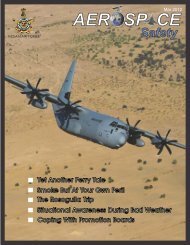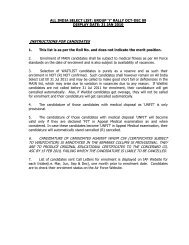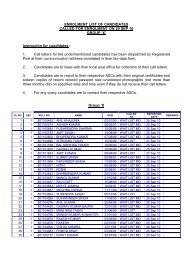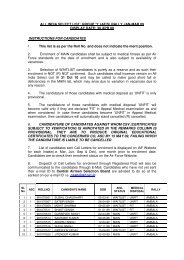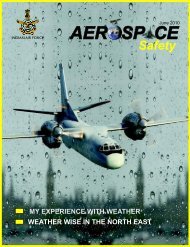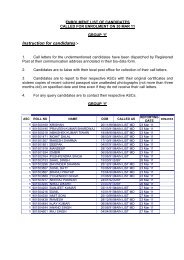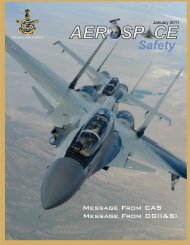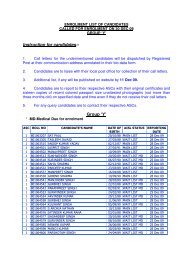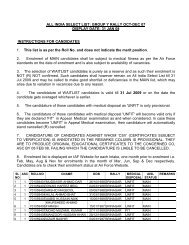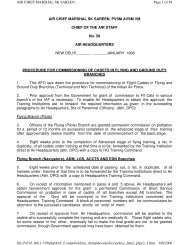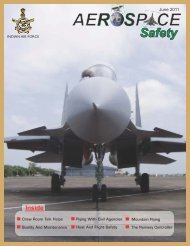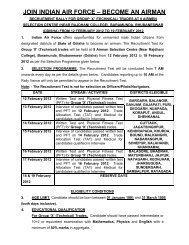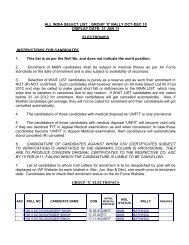Create successful ePaper yourself
Turn your PDF publications into a flip-book with our unique Google optimized e-Paper software.
level was rapidly increasing. Eventually, I piped up<br />
on R/T and asked the leader to abort the mission.<br />
I expected a positive reply and mentally prepared<br />
myself for subsequent actions. However, when<br />
the leader called to ‘continue’, I was shocked.<br />
My professional competence was getting<br />
sandwiched between taking a safe decision and<br />
continuing with the mission. Our formation also<br />
had pilots with lesser experience who were also<br />
continuing without expressing their discomfort.<br />
The reason for their silence was not difficult to<br />
predict at that moment. They behaved as true<br />
followers with immense faith in their leader. This<br />
fact hit my professional ego - ’if they could do it<br />
then why not me’. The ‘Formation’ integrity was<br />
being challenged at every step due to extended<br />
trails of clouding and the worst was yet to come.<br />
Finally, one of the junior pilots expressed his<br />
discomfort on R/T and requested to abort the<br />
mission. By this time our ‘Formation’ had already<br />
entered the black turbulent wall of clouds. A<br />
turn about was ordered after establishing height<br />
separation which was a bit relaxing but a big<br />
challenge of avoiding a mid air collision loomed<br />
large! Our ‘Formation’ at this time was over the<br />
hills where the ‘Route Safety Altitude’ was as<br />
high as 16500’. The ordered maneuver was being<br />
executed with standard height separation.<br />
A conventional turn-about in a large formation<br />
in perfect VMC requires clearances from various<br />
members to avoid collision whereas in the said<br />
condition it was getting executed in nil visibility<br />
conditions, without any clue of relative positions<br />
of the other members! The turbulence was so<br />
severe that 1000’ height separation appeared<br />
very less. All of us were flying on instruments<br />
and struggling against turbulence to maintain<br />
flying parameters. The thought of other aircraft in<br />
close proximity was the scariest of all. The stage<br />
was all set for disorientation i.e large formation,<br />
height maintenance, turbulent weather and nil<br />
visual references. The silence was broken by two<br />
R/T calls- first one of ‘HUD failure’ from No.2 and<br />
the second of ‘TGT Amplifier failure’ from the<br />
formation leader.<br />
After a long battle (short on time domain)<br />
with our machines and weather, the formation<br />
eventually broke clouds. The sky was visible in<br />
patches. It took another couple of minutes and a<br />
long series of R/T calls and aircraft manoeuvring<br />
before we could re-establish our formation and<br />
recover at our base. During the mission debrief<br />
few more tales about individual discomfort<br />
came to light and the scariest amongst all<br />
was the one associated with ‘HUD failure’. ‘All<br />
is well that ends well’ applied perfectly to our<br />
formation<br />
A few lessons emerged out of this incident<br />
which should make us wiser :-<br />
‘Respect Weather’- universally published<br />
but least followed.<br />
A perfect balance should be maintained<br />
between professional ego/competence and<br />
safety.<br />
Every member of a formation is equally<br />
responsible for formation safety. Decide and act<br />
in time before things go out of hand.<br />
Formation leaders must take decisions<br />
based on the least experienced member.<br />
Respect decisions of juniors as well.<br />
Do not let your ego overpower a safe<br />
decision.<br />
During peace time missions do not push<br />
your luck too hard for it to favour you on every<br />
occasion.<br />
Peculiarity of weather over hills should<br />
be emphasized in detail for missions involving<br />
valley/hill transit.<br />
Let your experience benefit others for a<br />
better flight safety environment.<br />
-Sqn Ldr R Kadyan<br />
INDIAN AIR FORCE 2 0 1 2 J u n e Aerospace Safety 11



